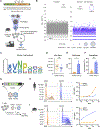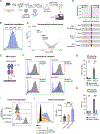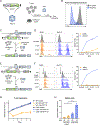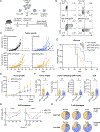An evolved AAV variant enables efficient genetic engineering of murine T cells
- PMID: 36638795
- PMCID: PMC10540678
- DOI: 10.1016/j.cell.2022.12.022
An evolved AAV variant enables efficient genetic engineering of murine T cells
Abstract
Precise targeting of large transgenes to T cells using homology-directed repair has been transformative for adoptive cell therapies and T cell biology. Delivery of DNA templates via adeno-associated virus (AAV) has greatly improved knockin efficiencies, but the tropism of current AAV serotypes restricts their use to human T cells employed in immunodeficient mouse models. To enable targeted knockins in murine T cells, we evolved Ark313, a synthetic AAV that exhibits high transduction efficiency in murine T cells. We performed a genome-wide knockout screen and identified QA2 as an essential factor for Ark313 infection. We demonstrate that Ark313 can be used for nucleofection-free DNA delivery, CRISPR-Cas9-mediated knockouts, and targeted integration of large transgenes. Ark313 enables preclinical modeling of Trac-targeted CAR-T and transgenic TCR-T cells in immunocompetent models. Efficient gene targeting in murine T cells holds great potential for improved cell therapies and opens avenues in experimental T cell immunology.
Keywords: AAV; CAR-T cell; CRISPR/Cas9; Gene Editing; Gene targeting; Genome wide CRISPR screen; Immunology; T cell; Trac-CAR.
Copyright © 2022 The Authors. Published by Elsevier Inc. All rights reserved.
Conflict of interest statement
Declaration of interests J.A., W.A.N., J.E., and A.A. are co-inventors on a patent application filed on the subject matter of this study. A.A. is a cofounder and board member at StrideBio and TorqueBio. J.E. is a compensated co-founder at Mnemo Therapeutics and a compensated scientific advisor to Cytovia Therapeutics. J.E. owns stocks in Mnemo Therapeutics and Cytovia Therapeutics. J.E. has received a consulting fee from Casdin Capital, Resolution Therapeutics and Treefrog Therapeutics. The J.E. lab has received research support from Cytovia Therapeutics, Mnemo Therapeutics, and Takeda Pharmaceutical Company.
Figures





References
-
- Shah NN., Qin H., Yates B., Su L., Shalabi H., Raffeld M., Ahlman MA., Stetler-Stevenson M., Yuan C., Guo S., et al.. (2019). Clonal expansion of CAR T cells harboring lentivector integration in the CBL gene following anti-CD22 CAR T-cell therapy. Blood Adv 3, 2317–2322. 10.1182/bloodadvances.2019000219. - DOI - PMC - PubMed
Publication types
MeSH terms
Grants and funding
LinkOut - more resources
Full Text Sources
Molecular Biology Databases
Research Materials

